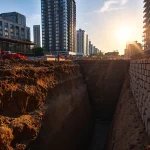Secant pile walls offer a reliable, efficient solution for deep urban excavations where space and stability are limited. By combining overlapping reinforced and unreinforced piles, they create strong, watertight barriers that minimise ground movement and support surrounding structures. Their adaptability to high water tables and strict deflection limits makes them essential in complex construction projects requiring precise, durable earth retention.
Comprehensive guide to secant pile walls for excavation and retention
Secant Pile Wall Construction Solutions play an integral role in modern ground engineering, combining robust structural design with adaptability for a wide range of site conditions. A secant pile wall is constructed by alternately installing primary and secondary bored piles, with the secondary piles slightly cutting into the primary ones to create a continuous, interlocking barrier. This method forms a homogeneous retaining structure capable of withstanding substantial lateral and vertical loads, often required for urban excavations and basement developments.
A voir aussi : Asbestos surveys london: protect your property and ensure safety
Secant pile walls are classified by the composition of their interlocking piles. In the hard/hard configuration, both primary and secondary piles use structural concrete, providing optimal strength and water resistance—a suitable choice for high water table areas or where maximum retention is necessary. The hard/soft setup pairs concrete-reinforced secondary piles with softer, sometimes cement-bentonite, primary piles, balancing cost-effectiveness and load-bearing capacity in moderate soil and moisture conditions.
Key engineering concepts in secant pile design include the interlocking mechanism—critical for water cutoff and soil retention—the strict maintenance of verticality during installation, and structural reinforcement through steel cages or beams. This approach not only ensures exceptional positional accuracy but also facilitates minimal movement of adjacent structures, making secant pile walls uniquely adaptable for complex or restricted urban sites.
Cela peut vous intéresser : How to Create a Comprehensive Digital Marketing Plan for a Belfast Spa?
Secant pile wall construction: process, techniques, and best practices
Step-by-step construction overview: from guide walls to pile installation and alignment controls
Precision in secant pile wall construction starts at ground level with the installation of a guide wall for secant piling. The guide wall ensures line, level, and correct spacing throughout the secant pile construction sequence. Following this, primary (female) piles are drilled and concreted using specified secant pile installation techniques, such as rotary bored or CFA (Continuous Flight Auger) methods. Once the primary piles have set, secondary (male) piles are installed, overlapping the primaries and forming the continuous wall. This creates the interlock needed for both watertightness and structural strength.
Machine and technique selection: CFA, rotary bored, segmental casing, cased CFA, and associated equipment
The selection of secant pile wall construction equipment is informed by ground conditions, wall geometry, and project constraints. CFA secant pile installation techniques offer rapid, low-vibration construction, especially beneficial in sensitive urban locations. Rotary bored rigs can achieve greater depths and are paired with segmental casing or the cased secant piling method where ground stability demands higher precision and control.
Quality control, verticality testing, and site monitoring protocols
Ensuring secant pile wall verticality is maintained by alignment monitoring at each stage. Verticality and pile integrity are checked through real-time site monitoring and post-installation verticality testing. Site protocols require continuous assessment using advanced secant pile wall drilling technology and test data review to detect any deviations quickly. Consistent adherence to these practices protects structural integrity, water cutoff performance, and project timelines.
Design principles and structural considerations for secant wall systems
Secant pile design principles require careful calculation of wall thickness, pile diameter, and reinforcement levels based on site conditions. The SQuAD method shows precision improves with the accurate match between predicted wall cross-sections and engineering requirements. Wall thickness standards for secant pile walls are determined by hydrogeological factors and the vertical alignment in secant pile walls, ensuring continuous contact and minimal water ingress.
Horizontally locked secant piles provide crucial soil retention and load capacity, particularly in sites with variable soil types. Soil types for secant pile walls dictate the composition of both primary (weaker, often unreinforced) and secondary (fully reinforced) piles, and influence pile diameter and reinforcement details. For high water tables, wall thickness is increased, and the horizontal interlock of secant piles becomes vital.
Achieving structural stability involves attention to load transfer, limiting wall deflection, and maintaining strict vertical alignment in secant pile walls. Reinforcement details are tailored to anticipated settlement parameters and soil conditions.
Innovative solutions include using steel cages, I-beams, or advanced anchors for reinforcement, as well as permanent anchors and propping systems. Cantilever secant pile wall design is favored for temporary works, while permanent structures often employ multi-propped arrangements. Each configuration is optimized during design for the anticipated soil and load conditions, ensuring resilience and longevity.
Typical and advanced applications for secant pile walls in urban and infrastructure projects
Secant pile walls in urban construction are selected for their ability to support deep excavations in settings where space is limited or close to existing structures. Using the Stanford Question Answering Dataset (SQuAD) approach: “What are typical applications of secant retaining wall applications?” — They are used for excavation support, deep basement construction, cut-off walls, and to stabilize slopes, especially in dense city centres.
Deep basement and cut-off wall construction for high-rise and mixed-use developments
Secant piles for basement excavation create embedded, nearly watertight retaining barriers, effectively sealing excavations against groundwater ingress. The mechanism of secant pile wall formation—overlapping primary and secondary piles—provides robust soil retention and lateral support, critical for safeguarding adjacent buildings. Advanced methods enable optimum wall alignment and shape flexibility, directly suiting the complex footprints common to high-rises and mixed-use sites.
Supporting excavations, tunnels, highways, slope stabilization, and flood defense
Secant retaining wall applications extend to tunnel approaches, highway underpasses, and slope protection, delivering stability in variable soils or high groundwater tables. Application of secant piles in deep excavations for public transport shafts or utility corridors ensures minimal surface disruption and settlement. Secant piles for flood defense walls also function as watertight barriers in critical infrastructure, particularly in sites prone to flooding.
Custom solutions for maximising land use and integrating within constrained urban sites
Secant pile wall public infrastructure uses facilitate maximized site development, integrating new foundations with existing underground structures. Their adaptability supports creative land use, allowing designers to contour the wall shape to property boundaries or weave around services, making secant pile walls in urban construction the preferred solution for challenging city projects.
Comparison with Alternative Retention and Shoring Systems
Technical and Performance Differences: Secant vs Diaphragm, Contiguous, Sheet, and Soldier Pile Walls
Using the SQuAD method: A secant pile wall offers greater water tightness and shape adaptability than a diaphragm wall. Compared to a contiguous pile wall, secant piles close soil gaps, providing improved groundwater cutoff. Sheet pile retaining wall vs secant walls reveals secant systems deliver significantly higher lateral strength and allow deeper penetrations. Soldier pile vs secant pile wall costs are typically higher for secant due to more complex construction.
Secant pile wall construction features alternating reinforced and unreinforced piles, enabling near-continuous, robust earth retention. Diaphragm wall comparison highlights that secant walls are less demanding in equipment footprint but excel in irregular sites where shape flexibility is essential. Contiguous pile wall vs secant piles: contiguous walls suit dry, stable ground but lack watertightness.
Suitability for Varying Ground Conditions and Project Requirements
Secant pile wall design principles adapt well to high groundwater and soft or variable soils, making them invaluable for deep excavations, especially in tight or urban settings. Sheet pile retaining wall vs secant walls shows secant systems are less prone to leakage or deformation, supporting complex basement construction.
Construction Footprint, Shape Flexibility, Vibration, Noise, and Installation Speed
Secant pile shoring system benefits from low noise and vibration, a key distinction from sheet and soldier pile methods. The construction sequence optimizes limited space: secant walls fit irregular boundaries and weave between structures, ideal for city sites. Diaphragm wall comparison further illustrates that secant pile wall construction produces a smaller operational footprint and enables adaptation to spatial constraints.
Cost, regulatory, and environmental factors in secant pile wall projects
Cost influences: Pile type, diameter, depth, reinforcement, installation speed, and complexity
Secant pile wall cost factors are driven foremost by the pile type—hard/soft, hard/firm, or hard/hard—each influencing material and labor expenses. Increasing pile diameter and depth naturally raises the typical project cost for secant walls, especially in dense urban environments or where deeper soil retention is needed. Reinforcement with steel cages or I-beams also adds to overall expenditure. Installation speed impacts costs: faster, specialized rigs can reduce time but often require a higher investment up front. Complex site conditions, such as restricted access or unpredictable soil profiles, can require adjustments in the secant pile wall construction sequence and specialized equipment.
Comparison with contiguous piles reveals that cost comparison between secant and contiguous piles often favors secant pile systems in water-sensitive or irregular excavations due to their water-tightness and adaptability, though contiguous systems may be less expensive in standard settings.
Environmental considerations: Noise, vibration, water control
The environmental impact of secant walls is addressed through technologies aiming for noise and vibration reduction. Environmental protection during secant wall construction involves dewatering controls and careful spoil management to safeguard groundwater and minimize soil disturbance, contributing to sustainability.
Regulatory standards and compliance
Regulatory standards for secant pile walls demand compliance with both national and site-specific requirements. Adherence to these ensures the safety and structural integrity expected in urban, infrastructure, or environmentally sensitive projects—supported by rigorous quality control and precise vertical alignment throughout construction.
Operation, maintenance, performance, and risk management in secant pile wall systems
Monitoring structural performance, movement, and waterproofing effectiveness
According to SQuAD principles: Precision focuses on detecting differences between predicted and actual secant pile wall movement, while recall tracks identified issues versus all possible movement events. Consistent monitoring secant pile wall movement is vital, using precision instruments to track lateral displacements and verify waterproofing. Early warning sensors enable engineers to promptly detect changes, supporting prompt troubleshooting secant pile wall constructions and ensuring successful waterproofing in installations exposed to high groundwater.
Maintenance schedules, quality assurance, and addressing causes of wall failure
Structured secant pile wall maintenance guidelines require planned inspections of capping beams, interlock joints, and drainage systems. Effective programmes hinge on secant pile wall performance analysis—pressure readings and load tests help identify deterioration and potential secant pile wall failure causes, like soil washout or inadequate reinforcement overlap. Robust documentation enables proactive responses before expensive repairs are needed, and thorough records help with troubleshooting secant pile wall constructions.
Safety protocols and managing operational risk throughout the lifecycle
Rigorous safety considerations for pile wall construction are integral from installation to decommissioning. Crews must adhere to strict barriers, personal protective equipment, and confined-space procedures to mitigate risks. Regular safety audits, documentation of incidents, and frequent training refreshers reinforce safe operations and reduce the risk of secant pile wall failure causes related to procedural lapses. Ongoing review of risk management practices adapts to evolving site and regulatory requirements.










